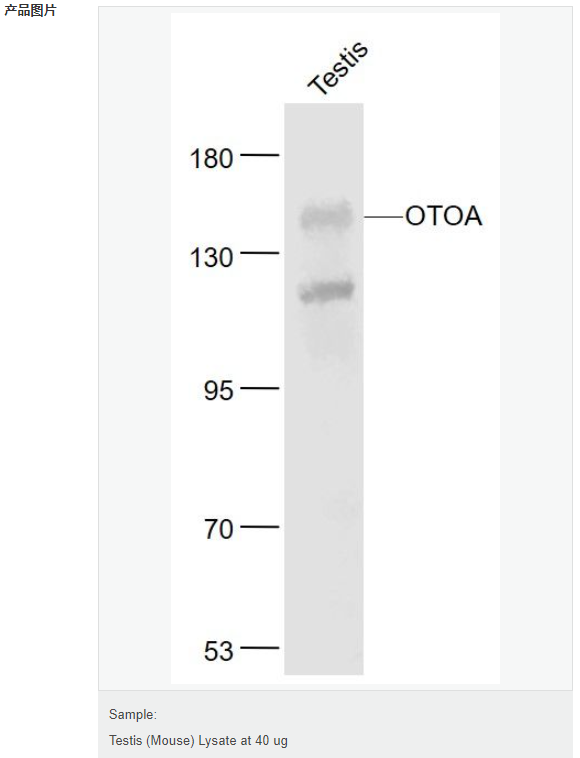

货号
产品规格
售价
备注
BN40283R-100ul
100ul
¥2360.00
交叉反应:Mouse(predicted:Human,Rat) 推荐应用:WB,ELISA
BN40283R-200ul
200ul
¥3490.00
交叉反应:Mouse(predicted:Human,Rat) 推荐应用:WB,ELISA
产品描述
| 英文名称 | OTOA |
| 中文名称 | 耳聋、常染色体隐性遗传22抗体 |
| 别 名 | Cancer/testis antigen 108; CT108; Deafness, autosomal recessive 22; DFNB22; OTOA; OTOAN_HUMAN; Otoancorin. |
| 研究领域 | 神经生物学 细胞粘附分子 细胞外基质 |
| 抗体来源 | Rabbit |
| 克隆类型 | Polyclonal |
| 交叉反应 | Mouse, (predicted: Human, Rat, ) |
| 产品应用 | WB=1:500-2000 ELISA=1:5000-10000 not yet tested in other applications. optimal dilutions/concentrations should be determined by the end user. |
| 分 子 量 | 122kDa |
| 细胞定位 | 细胞膜 细胞外基质 分泌型蛋白 |
| 性 状 | Liquid |
| 浓 度 | 1mg/ml |
| 免 疫 原 | KLH conjugated synthetic peptide derived from human OTOA/DFNB22:231-330/1153 |
| 亚 型 | IgG |
| 纯化方法 | affinity purified by Protein A |
| 储 存 液 | 0.01M TBS(pH7.4) with 1% BSA, 0.03% Proclin300 and 50% Glycerol. |
| 保存条件 | Shipped at 4℃. Store at -20 °C for one year. Avoid repeated freeze/thaw cycles. |
| PubMed | PubMed |
| 产品介绍 | Otoancorin, also known as OTOA, CT108 or DFNB22, is a 1,153 amino acid protein belonging to the stereocilin family. Expressed in the inner ear and restricted to the interface between the apical surface of sensory epithelia, otoancorin is suggested to act as an adhesion molecule. Otoancorin ensures the attachment of the inner ear acellular gels to the apical surface of the underlying nonsensory cells. Mutations in the gene encoding otoancorin leads to deafness autosomal recessive type 22 (DFNB22), which is a form of sensorineural hearing loss. Sensorineural deafness results from damage to the neural receptors of the inner ear, the nerve pathways to the brain or the area of the brain that receives sound information. Existing as three alternatively spliced isoforms, otoancorin is encoded by a gene located on human chromosome 16p12.2. Function: May act as an adhesion molecule. Subcellular Location: Apical cell membrane. Secreted > extracellular space > extracellular matrix. At the interface between the apical surface of the epithelia and the overlying acellular gel of the tectorial and otoconial membranes. DISEASE: Defects in OTOA are the cause of deafness autosomal recessive type 22 (DFNB22) [MIM:607039]. DFNB22 is a form of sensorineural hearing loss. Sensorineural deafness results from damage to the neural receptors of the inner ear, the nerve pathways to the brain, or the area of the brain that receives sound information. Similarity: Belongs to the stereocilin family. SWISS: Q7RTW8 Gene ID: 146183 Database links: Entrez Gene: 146183 Human Entrez Gene: 246190 Mouse Omim: 607038 Human SwissProt: Q7RTW8 Human SwissProt: Q8K561 Mouse Unigene: 408336 Human Important Note: This product as supplied is intended for research use only, not for use in human, therapeutic or diagnostic applications. |
